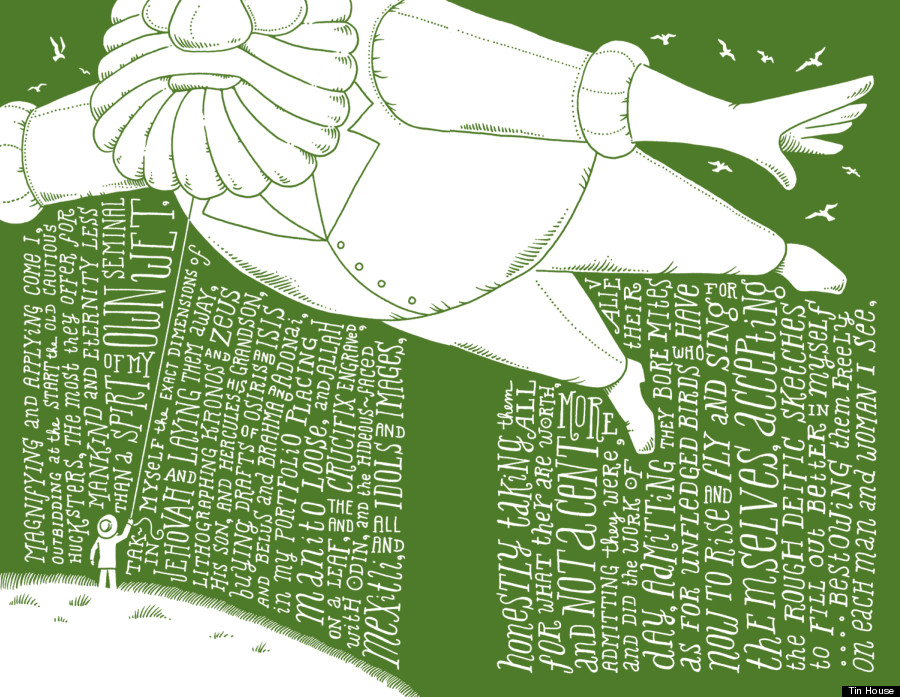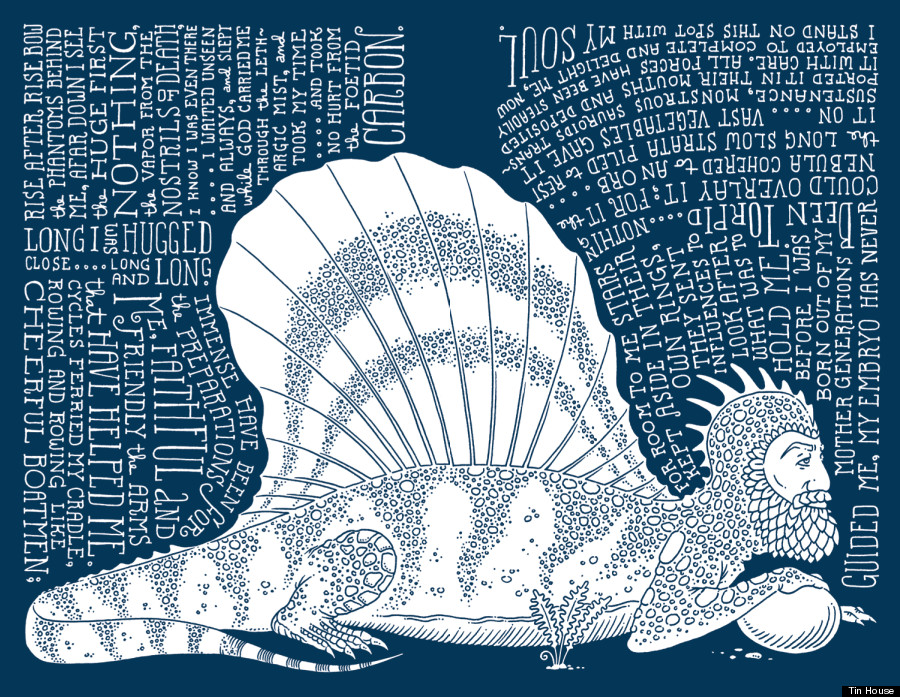The following is an excerpt from Whitman Illuminated: Song of Myself [Tin House Books, $28.95], illustrated by Allen Crawford, who lives in Whitman's "former backyard":
I live outside of Philadelphia, where Walt Whitman spent his last decades. I know the wooded banks of Big Timber Creek, where he rested and slowly recovered from the stroke he suffered after the Civil War. I've kayaked in the cove behind Petty's Island on the Delaware Rver, where Whitman would picnic on weekends with his friend and amanuensis, Horace Traubel. I've visited his Mickle Street house in Camden many times, and have stood in his bedroom, where his metal washtub is tucked under his heavy wooden bed. And I know exactly when the mountain laurels outside of his crypt in Harleigh Cemetery are in bloom.
I'm very fortunate to live in Whitman's former backyard: He left a trove of materials and personal effects for local archivists and historians to sift through. It would have been difficult to do a Whitman-based project if I didn't have close access to the Philadelphia institutions that safeguard his legacy. To hold, feel, and study Whitman's books and letters first-hand enriched the endeavor of giving his work a new incarnation.

It's become commonplace, even cliche, to suggest that Whitman's iconic collection of poems. Leaves of Grass, is a kind of sacred American text. Whitman himself made such comparisons, going so far as to use biblical verse as a model for his own. So it seems fitting that his work should be transcribed by hand, the way the monks illuminated Holy Scripture in the Middle Ages.
Whitman wanted to create a new form of verse, one that was indigenous to America. He wanted to break free not only in form but in content: He sought complete candor, not allegory or symbolism. His sensibility was American: exuberant, rough, and wild. He reveled in the vitality and sublimity of the physical. He exalted the nature around and within us. His work is an expression of primal joy: He celebrated our animal senses, and the pleasures of being alive.
What you are now holding in your hands is an illustrated interpretation of Whitman's epic poem, "Song of Myself," which is the centerpiece of Leaves of Grass. The version of "Song of Myself" used here is from the original 1855 edition of Leaves of Grass. I decided to transcribe and illustrate the 1855 edition because to my unscholarly eye it seems the most energetic, raw, and uncompromising.
With this book, I've tried to make the vigor of "Song of Myself" tangible. I've attempted to liberate the words from their blocks of verse, and allow the lines to flow freely about the page, like a stream or a bustling city crowd. The text and imagery in this book are intended to be in keeping with Whitman's unfurnished sensibility. In the process, Whitman's sixty-page poem has been protracted into 234 illustrated pages.

"Protracted" seems a particularly apt word in this case: To complete the book I spent a year in my basement, working well into the wee hours, lapsing into a nocturnal pattern, as I often do with large projects. My setup in the basement is simple: two drafting tables, tracing paper, pens, vellum, and a light box. Each two-age spread started as a thumbnail, and then worked into a full-size pencil layout. It was then inked up, scanned, cleaned up digitally, and edited before being saved as final art. It took about eight to ten hours to complete each two-page spread. By my rough estimate, I devoted about 2,560 hours to this book. During the coldest weeks of winter, I was often wrapped in multiple house robes, socks, boots, and a Russian fur hat. I did my best to make a decent workstation for myself, but at times my shoulders, neck, and wrist were locked up in great pain from holding contorted positions in the cold for hours at a time. Each night before bed, I slathered my hand in sports cream and covered it with a sock, like an aging baseball player.
The book was improvised, not planned. So much effort was put into each spread that I never could work out in advance what I was going to draw on the following day. Each morning I felt as though I was starting all over again. The hardest part was working out what the next image would be. Would it be pictorial? Lyrical? Emblematic? Surreal? Typographical? Playful?
I sometimes think of this project as a visual journal that I kept as I explored the wild expanses of Whitman's poem, surveying and documenting each line as I went. I wanted to make this book an object that is viewed as well as read, and I made every effort to encapsulate a complete thought or mood one each spread before moving on to the next cluster of verse. There are parts where the pages spill into each other, but generally each spread retains its own imagery, personality, and mood--although there is an overall visual theme throughout the book to maintain some measure of cohesion.

I tried to make sure that I wasn't merely reflecting the poem, which would be redundant, predictable, and boring. I'm sure I didn't always succeed, but my goal was to leave an interpretative gap for the reader-- or should I say "viewer"--between the poem and my responses (I'm not sure all the drawings can be properly called "illustrations"). My hope is that you will never quite know what to expect when you turn the page.
To maintain the reader's interest (and my own), I tried to vary the density and complexity from page to page, alternating between pages crammed with text and pages that incorporate imagery. A few pages have little more than imagery. Deciding what to emphasize was a largely intuitive process as I made my way through the text.
Whitman's verse concerns itself with epic sweeps and grand gestures, which means including nearly everything and everyone. Walt did indeed contain multitudes, and I had to follow his lead if I was going to properly serve his words. At times, this could prove exasperating: Keeping up with Whitman's torrents of people and places sometimes felt like riding a bee-stung bison down the aisle of a bus.
I found that in order to add anything at all to Whitman's panorama of people and places, I had to add a dimension of my own. Events in my daily life affected my approach to each spread,a nd the Philadelphia of today seeped into the Philadelphia of Whitman's day. Thus, you'll find a variety of contemporary or near-contemporary images in this book. Not doing so would have been a disservice to Whitman's work, whig attempts to create a new form of verse for The Here and The Now.
For this project, I wanted to use a drawing style that is slightly awkward and plain, with a minimum of self-consciousness. I spent a couple of weeks testing out certain combinations of pens and paper, until I found a pairing that had the kind of friction that prevents facile, fussy flourishes. I hope this rather plainspoken drawing style will suggest or invoke the sensibilities espoused by Whitman: his rough vigor, his earthy frankness, his dreamy expansiveness, and his reverence for life in all its forms.
I should give thanks and proper credit to Zak Smith and Matt Kish for inspiring this project. Zak Smith took it upon himself to illustrate every single page of Thomas Pynchon's Gravity's Rainbow, and Matt Kish soon followed by illustrating every single page of Herman Melville's Moby-Dick. Their steadfast devotion to such ambitious self-appointed projects was an inspiration, and so I decided to join them in their quest to lend new interpretations to American classics. I hope more will follow their lead.
This of you interested in learning more about Walt Whitman the person should find and read Specimen Days, the biography Walt Whitman: A life by Justin Kaplan, and the accounts of Horace Traubel. The bluster of Whitman's poems are swept aside to reveal a flawed but down-to-earth, maternally tender human being. Having read these books, I feel certain I would have loved the man, if I had known him.
Obviously, to attach one's own name to Walt Whitman's, one off the great names of American letters, is an incredibly presumptuous thing to do. I can only hope that I've atoned for my presumptuousness with my labor, and readers find I've done the words of The Good Gray Poet some justice. In any case, it was a privilege to make such an attempt.
At the close of "Song of Myself" Whitman invites us to look for him under our boot-soles. It's my hope that readers of this book might also find a little of him under my pen.